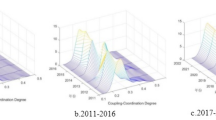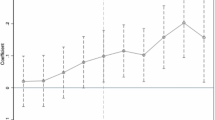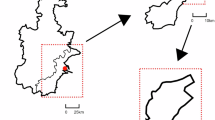Abstract
Mitigation and adaptation strategies are recognized as effective means to enhance urban resilience against climate change; however, their combined effects at the urban level are less studied. Here we investigate the synergistic impacts of low-carbon and climate-resilient pilot policies on urban resilience, using panel data from 286 Chinese cities (2005–2022). The findings indicate that dual-pilot policies significantly enhance the low-carbon resilience of pilot cities, outperforming single-pilot policies. The effectiveness of these policies exhibits variation across different city categories: cities subjected to extreme weather and high disaster risks demonstrate more pronounced benefits, whereas medium ecological and economic low-carbon resilience, high social low-carbon resilience and medium institutional low-carbon resilience (MMHM) cities show consistent effects and low ecological, economic, social and institutional low-carbon resilience (LLLL) cities exhibit varied responses. Furthermore, green technology innovation, human capital development and communication infrastructure are critical to improving policy effectiveness. The diversity and integration of policy instruments, along with the multidimensionality and synergy of policy objectives, are essential for effective climate action. It is recommended that cities integrate both mitigation and adaptation strategies to optimize synergies and bolster urban resilience.
This is a preview of subscription content, access via your institution
Access options
Subscribe to this journal
Receive 12 digital issues and online access to articles
$119.00 per year
only $9.92 per issue
Buy this article
- Purchase on SpringerLink
- Instant access to full article PDF
Prices may be subject to local taxes which are calculated during checkout



Similar content being viewed by others
Data availability
The economic, social and ecological data for Chinese cities were initially sourced from the following: (1) The China Urban Statistical Yearbook, China Urban Construction Statistical Yearbook, China Regional Economic Statistical Yearbook and China Meteorological Disaster Yearbook from various years. These yearbooks are available on the China Economic and Social Big Data Research Platform (https://data.cnki.net/). (2) The statistical yearbooks of various provinces and cities in China, as well as the official websites of city governments in China. These can be accessed through the official websites of the statistical bureaus and governments of the respective provinces and cities in China. (3) The weather data for Chinese cities were initially obtained from the National Qinghai-Tibet Plateau Science Data Center (https://data.tpdc.ac.cn/home) and the Resources and Environment Science Data Center of the Chinese Academy of Sciences (https://www.resdc.cn/). The result table includes the extended dataset Source Data Figure 2, and Table 1 and Table 2 in the main text. Other data can be provided by the corresponding author upon reasonable request. Source data are provided with this paper.
Code availability
The algorithm version used for performing DML analysis is available via GitHub at https://github.com/py-why/EconML.
References
Mora, C. et al. Broad threat to humanity from cumulative climate hazards intensified by greenhouse gas emissions. Nat. Clim. Change 8, 1062–1071 (2018).
VijayaVenkataRaman, S., Iniyan, S. & Goic, R. A review of climate change, mitigation and adaptation. Renew. Sustain. Energy Rev. 16, 878–897 (2012).
Ranabhat, S., Ghate, R., Bhatta, L. D., Agrawal, N. K. & Tankha, S. Policy coherence and interplay between climate change adaptation policies and the forestry sector in Nepal. Environ. Manag. 61, 968–980 (2018).
Hurlimann, A., Moosavi, S. & Browne, G. R. Urban planning policy must do more to integrate climate change adaptation and mitigation actions. Land Use Policy 101, 105188 (2021).
Sebestyén, V., Dörgȍ, G., Ipkovich, Á. & Abonyi, J. Identifying the links among urban climate hazards, mitigation and adaptation actions and sustainability for future resilient cities. Urban Clim. 49, 101557 (2023).
Rosenzweig, C., Solecki, W., Hammer, S. A. & Mehrotra, S. Cities lead the way in climate-change action. Nature 467, 909–911 (2010).
Solecki, W. et al. A conceptual framework for an urban areas typology to integrate climate change mitigation and adaptation. Urban Clim. 14, 116–137 (2015).
Reckien, D., Flacke, J., Olazabal, M. & Heidrich, O. The influence of drivers and barriers on urban adaptation and mitigation plans—an empirical analysis of European cities. PLoS ONE 10, e0135597 (2015).
IPCC. Climate Change 2007: Impacts, Adaptation and Vulnerability (eds Parry, M. L. et al.) (Cambridge Univ. Press, 2007).
Sharifi, A. Trade-offs and conflicts between urban climate change mitigation and adaptation measures: a literature review. J. Clean. Prod. 276, 122813 (2020).
Chen, L. & Wang, K. The spatial spillover effect of low-carbon city pilot scheme on green efficiency in China’s cities: evidence from a quasi-natural experiment. Energy Econ. 110, 106018 (2022).
Cheng, J., Yi, J., Dai, S. & Xiong, Y. Can low-carbon city construction facilitate green growth? Evidence from China’s pilot low-carbon city initiative. J. Clean. Prod. 231, 1158–1170 (2019).
Pan, A., Zhang, W., Shi, X. & Dai, L. Climate policy and low-carbon innovation: evidence from low-carbon city pilots in China. Energy Econ. 112, 106129 (2022).
Zheng, Y., Zhai, J. Q., Wu, Z. Y., Li, Y. & Shi, W. N. Classification evaluation of resilient cities based on adaptive cycle—an example of sponge city and climate-adapted city pilot in China. Chin. J. Popul. Resour. Environ. 28, 31–38 (2018).
Wang, D. & Chen, S. The effect of pilot climate-resilient city policies on urban climate resilience: evidence from quasi-natural experiments. Cities 153, 105316 (2024).
Fu, L., Yang, X., Zhang, D. & Cao, Y. Assessment of climate-resilient city pilots in China. Chin. J. Urban Environ. Stud. 9, 2150005 (2021).
Zhou, Z. F. et al. Climate governance actions and corporate environmental responsibility fulfillment—evidence from climate resilient city construction. J. Beijing Inst. Technol. 26, 38–55 (2024).
Howlett, M. & Rayner, J. in Routledge Handbook of Policy Design (eds Howlett, M. & Mukherjee, I.) 389–403 (Routledge, 2018).
Nilsson, M. et al. Understanding policy coherence: analytical framework and examples of sector–environment policy interactions in the EU. Environ. Policy Gov. 22, 395–423 (2012).
Di Gregorio, M. et al. Climate policy integration in the land use sector: mitigation, adaptation and sustainable development linkages. Environ. Sci. Policy 67, 35–43 (2017).
Wang, L., Shao, J. & Ma, Y. Does China’s low-carbon city pilot policy improve energy efficiency? Energy 283, 129048 (2023).
Wang, J. & Foley, K. Promoting climate-resilient cities: developing an attitudinal analytical framework for understanding the relationship between humans and blue-green infrastructure. Environ. Sci. Policy 146, 133–143 (2023).
Zou, C., Huang, Y., Wu, S. & Hu, S. Does ‘low-carbon city’ accelerate urban innovation? Evidence from China. Sustain. Cities Soc. 83, 103954 (2022).
Lin, B. B. et al. Integrating solutions to adapt cities for climate change. Lancet Planet. Health 5, e479–e486 (2021).
Angrist, N., Winseck, K., Patrinos, H. A. & Zivin, J. G. Human capital and climate change. Rev. Econ. Stat. https://doi.org/10.1162/rest_a_01444 (2024).
Shi, K., Liu, G., Cui, Y. & Wu, Y. What urban spatial structure is more conducive to reducing carbon emissions? A conditional effect of population size. Appl. Geogr. 151, 102855 (2023).
Chen, C., Xu, L., Zhao, D., Xu, T. & Lei, P. A new model for describing the urban resilience considering adaptability, resistance and recovery. Saf. Sci. 128, 104756 (2020).
Mi, Z. et al. Cities: the core of climate change mitigation. J. Clean. Prod. 207, 582–589 (2019).
Yari, A. et al. Definition and characteristics of climate-adaptive cities: a systematic review. BMC Public Health 24, 1200 (2024).
Turner, B. L. et al. A framework for vulnerability analysis in sustainability science. Proc. Natl Acad. Sci. USA 100, 8074–8079 (2003).
Reckien, D., Ewald, M., Edenhofer, O. & Liideke, M. K. What parameters influence the spatial variations in CO2 emissions from road traffic in Berlin? Implications for urban planning to reduce anthropogenic CO2 emissions. Urban Stud. 44, 339–355 (2007).
Granberg, M. & Elander, I. Local governance and climate change: reflections on the Swedish experience. Local Environ. 12, 537–548 (2007).
Ebi, K. L. et al. Extreme weather and climate change: population health and health system implications. Annu. Rev. Public Health 42, 293–315 (2021).
Vogel, B. & Henstra, D. Studying local climate adaptation: a heuristic research framework for comparative policy analysis. Glob. Environ. Change 31, 110–120 (2015).
He, X. et al. Implementation plan for low-carbon resilient city towards sustainable development goals: challenges and perspectives. Aerosol Air Qual. Res. 20, 444–464 (2020).
Song, H., Sun, Y. J. & Chen, D. K. Evaluating the effects of government air pollution control: an empirical study of China’s ‘low carbon cities’. Manag. World 35, 95–108 + 195 (2019).
Giles-Corti, B., Foster, S., Lynch, B. & Lowe, M. What are the lessons from COVID-19 for creating healthy, sustainable, resilient future cities? npj Urban Sustain. 3, 29 (2023).
Cejudo, G. M. & Trein, P. Pathways to policy integration: a subsystem approach. Policy Sci. 56, 9–27 (2023).
Rosenow, J., Kern, F. & Rogge, K. The need for comprehensive and well targeted instrument mixes to stimulate energy transitions: the case of energy efficiency policy. Energy Res. Social Sci. 33, 95–104 (2017).
Browne, G. R. et al. Better policy to support climate change action in the built environment: a framework to analyse and design a policy portfolio. Land Use Policy 145, 107268 (2024).
Mees, H. L. et al. A method for the deliberate and deliberative selection of policy instrument mixes for climate change adaptation. Ecol. Soc. 19, 58 (2014).
Huang, C., Yang, C. & Su, J. Policy change analysis based on ‘policy target–policy instrument’ patterns: a case study of China’s nuclear energy policy. Scientometrics 117, 1081–1114 (2018).
Endl, A., Gottenhuber, S. L. & Gugerell, K. Drawing lessons from mineral and land use policy in Europe: crossing policy streams or getting stuck in silos? Extract. Ind. Soc. 15, 101320 (2023).
Bemelmans-Videc, M. L., Rist, R. C. & Vedung, E. O. (eds) Carrots, Sticks, and Sermons: Policy Instruments and their Evaluation Vol. 1 (Transaction, 2011).
Peñasco, C., Anadón, L. D. & Verdolini, E. Systematic review of the outcomes and trade-offs of ten types of decarbonization policy instruments. Nat. Clim. Change 11, 257–265 (2021).
Lemaire, D. in Carrots, Sticks and Sermons (eds Bemelmans-Videc, M. L. et al.) 59–76 (Routledge, 2017).
Borrás, S. & Edquist, C. The choice of innovation policy instruments. Technol. Forecast. Soc. Change 80, 1513–1522 (2013).
Liu, X., Li, S., Xu, X. & Luo, J. Integrated natural disasters urban resilience evaluation: the case of China. Nat. Hazards 107, 2105–2122 (2021).
Jha, A. K., Miner, T. W. & Stanton-Geddes, Z. (eds) Building Urban Resilience: Principles, Tools, and Practice (World Bank Publications, 2013).
Ryan, C. Eco-acupuncture: designing and facilitating pathways for urban transformation, for a resilient low-carbon future. J. Clean. Prod. 50, 189–199 (2013).
Acknowledgements
This work was supported by the Humanities and Social Sciences Youth Foundation, Ministry of Education (no. 22YJC790120 to D.W.) and the National Social Science Fund of China (no. 22VMG016 to D.W.).
Author information
Authors and Affiliations
Contributions
Conceptualization: D.W. Resources: D.W. Project administration: D.W. Methodology: D.W. and S.C. Writing—original draft: S.C. Visualization: S.C. Writing—review and editing: D.W. and S.C. Supervision: D.W. Funding acquisition: D.W.
Corresponding authors
Ethics declarations
Competing interests
The authors declare no competing interests.
Peer review
Peer review information
Nature Cities thanks Bin Su and the other, anonymous, reviewer(s) for their contribution to the peer review of this work.
Additional information
Publisher’s note Springer Nature remains neutral with regard to jurisdictional claims in published maps and institutional affiliations.
Supplementary information
Supplementary Information
Supplementary Figs. 1–7, Discussion and Tables 1–4.
Source data
Source Data Fig. 2
The policy effects of the dual-pilot policy.
Source Data Table 1
The detailed results of the policy regression.
Source Data Table 2
The detailed results of the moderating effects.
Rights and permissions
Springer Nature or its licensor (e.g. a society or other partner) holds exclusive rights to this article under a publishing agreement with the author(s) or other rightsholder(s); author self-archiving of the accepted manuscript version of this article is solely governed by the terms of such publishing agreement and applicable law.
About this article
Cite this article
Wang, D., Chen, S. Synergistic action on mitigation and adaptation pilot policies to enhance low-carbon resilience of Chinese cities. Nat Cities 2, 812–824 (2025). https://doi.org/10.1038/s44284-025-00303-0
Received:
Accepted:
Published:
Issue date:
DOI: https://doi.org/10.1038/s44284-025-00303-0



